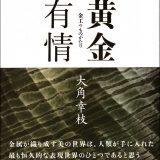As I learned more about netsuke, tobacco pouches, and sword fittings, I wanted to become better informed about Japanese metalwork. Even though I was familiar with Western-style gold and silver accessories just as many other Japanese women, Japanese metalwork in general seemed to be a male domain due to its close association with swords.
However, I began to feel more familiar and comfortable with the subject of Japanese metalwork after coming across one particular book. It is Ogon yujo: Kinko no monogatari by Osumi Yukie (Ribun Shuppan, 2016). If you are interested in the field, I highly recommend it. I will introduce the English version in my next post but, in the meantime, please let me outline the book, giving the reasons why I recommend it.
The author of this book, Osumi-sensei (note: “sensei” is a Japanese honorific often used for master and teacher), is the first female artist designated as a Living National Treasure in the field of tankin, a technique of shaping metal objects by hammering. In this book, she gives an overview of tankin and additional metalwork techniques as well as other Japanese crafts. She also recounts her personal history as a female artist. It is, so to speak, a metalwork version of Urushi no hanashi (The book of urushi – click here for details), which was actually one of her favorite books in her youth.
Tankin (hammering) is quite different from chokin (chasing or chiseling), a technique often used for sword fittings and kagamibuta netsuke. In fact, this book does not discuss netsuke, tobacco pouches, or even sword fittings (except in a small way). Although I am aware that visitors to my website may love such chased or chiseled items while not necessarily being interested in hammered metal, there are some good reasons why I recommend this book.
The first is that, even though Osumi-sensei specializes in hammering, she is also very competent in chasing. In this book she describes the techniques, materials, and tools of both, so you can learn about the two. Since the author is eminent in the field and has much experience, this book is a highly reliable source of information, unlike those written by non-specialists.
Moreover, for someone like me who knows little about metalwork, a description of techniques, materials, and tools can seem rather dull, and simply reads like a list of obscure words. However, in this book, such descriptions are a fascinating read with a human touch, interspersed with her own experiences and anecdotes, alluding to her masters and other leading figures in Japanese crafts. (Although there are no images of sword fittings, a few famous artists are mentioned, for example, in the descriptions of some of the techniques.)
In passing, this book mentions “kebori” (lit. hair carving, or line engraving), the same term also being used in netsuke carving, although the tools and techniques are somewhat different. I also found a few metalwork terms that are used in other disciplines of Japanese crafts. This seems to suggest that a cross-influence exists between various fields of Japanese crafts and, as a result, share the same words.
The second reason why I recommend this book is that it is written in a broad perspective, placing Japanese metalwork in a far-reaching historical and geographical context. The author elucidates various characteristics of metalwork in Japan, comparing them to those in other parts of the world, such as silverware in England. There is sure to be something you can relate to from your own knowledge and experience, making Japanese metalwork easier to understand.
The third reason is that the book is also full of insights into Japanese culture and crafts. This is likely to result from the author having studied various crafts, including ceramics, dyeing, and lacquerware. Osumi-sensei has also had extensive overseas experience, including a one-year study in the UK as a metalwork artist. In addition to such experiences, I also assume that she is a voracious reader. In this publication, for example, there are many references to other books and, as is often the case with foreign books, each chapter begins with a quote from a famous book or other source. This wouldn’t have been possible if she hadn’t read a large quantity of books!)
Furthermore, women will find much to relate to in the way of life and reasoning of the author who has been active in the male-dominated society of metalworking. That said, this book is also of enormous appeal to men. The field of metalwork is described in such an objective way that anyone can easily understand it.
This book will help you to become acquainted with metalwork and broaden your perspective on Japanese crafts and culture. In the next post, I’ll tell you about its English edition! (Click here to see the next post.)
Komada Makiko

Thank you for reading this far!
Please do check out the next
post by clicking here.


